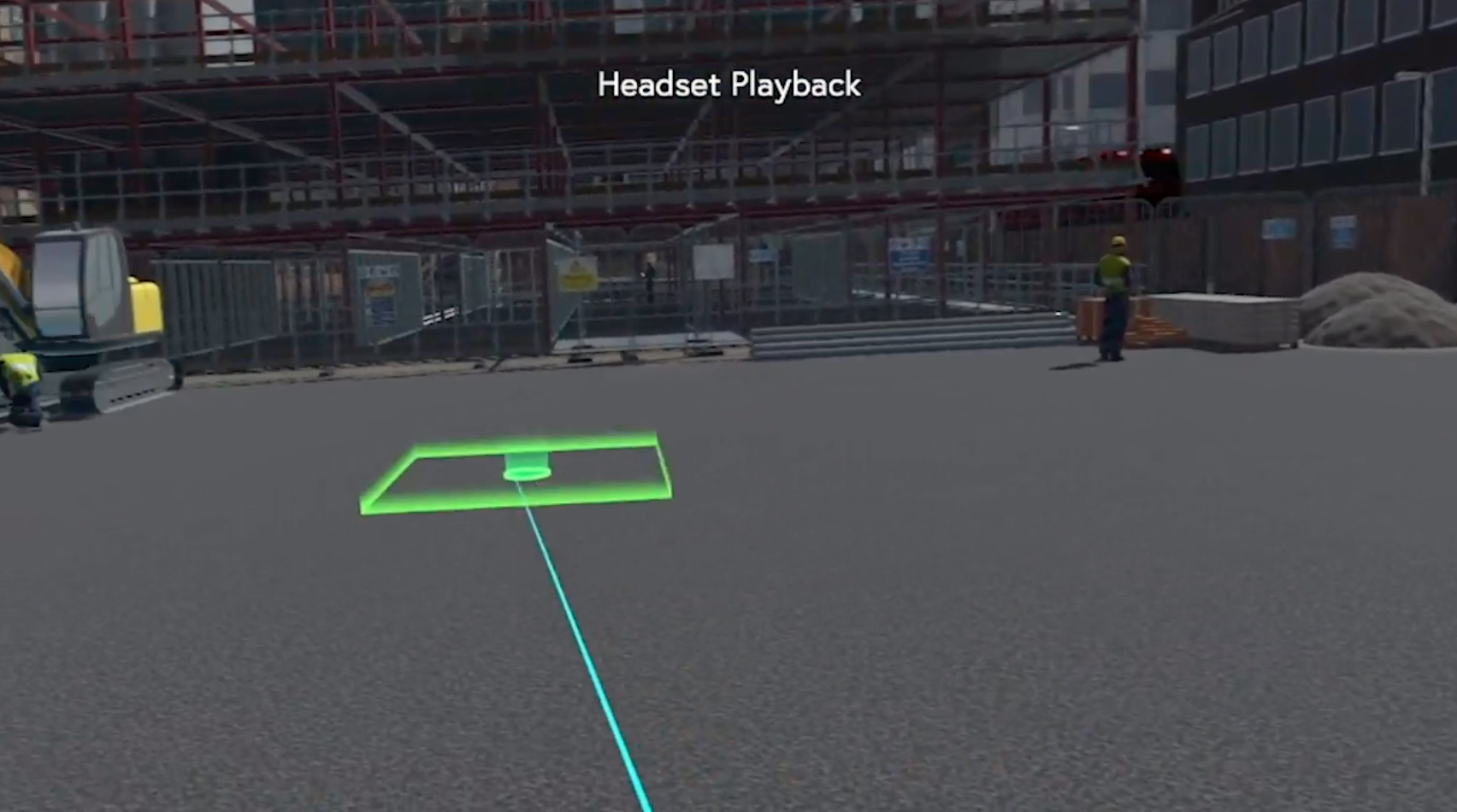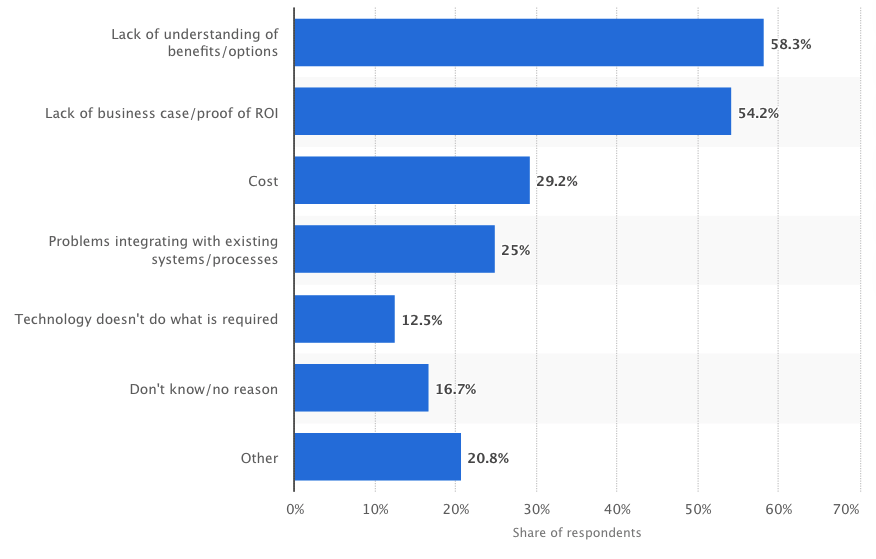Three-dimensional, computer-generated representations of our physical world have transformed the ways in which we live. Virtual reality (VR) opens the door to immersive experiences where users can interact with virtual objects and each other.
VR applications have continued to extend across sectors. Most notably, the gaming and entertainment industries have delivered some of the most prolific immersive experiences to date. Across the board, industries from healthcare, construction and retail and beyond have realised the potential of virtual reality to increase efficiencies, improve user experience and promote their brand.

(Share of business executives adopting VR technology worldwide as of 2018. Image: Statista)
VR technology has developed into a sophisticated tool, used to revolutionise the corporate environment – including training. The challenges posed by the long term impact of Covid-19 have forced us all to adapt to changing working environments. The increasingly remote-based workforce means that having a strong and reliable skills base has never been more important.
In light of these environmental changes, corporations and small businesses alike are scouting for ways to embed innovative ways to support skills development. VR training is at the forefront of this quest and poses promising opportunities for the future of job training.
Typically, companies have used VR to enable their employees to practice dealing with real-world scenarios, to develop a better understanding of a tool or product and to attend virtual seminars. For example, VR firm Strivr uses the virtual reality technology to prepare retail workers for large crowds on Black Friday. They simulate a busy store environment and allow employees to navigate their way through the store to highlight challenges and learn how to overcome them.
When Walmart partnered with Striver, associates using VR training reported 30% higher employee satisfaction, scored well on tests 70% of the time and displayed a 10 to 15% higher rate of knowledge retention than before the implementation of VR training. Since then, Walmart has extended the program to close to all of its 4,700 stores.
What channels are available for VR?
Many of us think of VR and envisage clumsy headsets and distorted images of an immersive environment. The technology has developed into a sophisticated and accessible tool that uses 3D images to immerse a user into a simulated environment- so much so, they feel like they’re actually there. Virtual Reality can effectively be broken down into three channels:
- Mobile VR – enabling users to insert their mobile devices into a VR headset. Merge VR and Blitzwolf VR create 3D VR glasses and VR headsets for iPhone 8 plus onwards and Xiaomi Samsung.
- Standalone VR – Those headsets which do not require any additional cables or devices to run. Popular options include Oculus Go and Oculus Quest.
- Desktop – VR powered by high-end computers and a VR headset. Examples included Oculus Rift and HTC Vive.
The cost-effectiveness for VR in corporate training is undisputed. Since VR headsets and technologies can be used time and time again – it’s one-off costs are effectively covered by the second training session.

(The reported price of leading consumer VR headsets in 2019 by the device. Image: Statista)
A variety of VR devices are available on the market – from inexpensive cardboard-based models that work with mobile devices to costly and professional-grade headsets. When it comes to training, each method has a role to play and can assist in developing the skills of a workforce.
Advantages of using VR in training
Immersive experiences
Engagement is critical to training outcomes. Traditional training methods would gather staff together to solve problems, learn about new products, explore ideas and practice using specific equipment. The immersive and interactive environment provided by VR boosts engagement of all staff equally – from afar. Meaning, each member of staff will be provided equal opportunity to engage in a team activity.
Practice makes perfect
In many industries, training staff can incur potentially devastating consequences. From the use of fragile equipment to the treatment of patients in the hospital, workers in demanding jobs can sharpen their skills within virtual environments without worrying about real-world repercussions. For example, practising in an industry using scarce or nonrenewable resources creates waste and incurs costs. VR simulated environments allow trainees to visualise and manipulate material without creating waste.

Enhanced creativity
Since all training is virtual, workers can take the risks they wouldn’t usually take in order to test new ideas and practices. This ability to pursue creative and high-risk solutions is necessary to propel any business forward and to create high levels of engagement in training sessions.
Enhanced training
The previewing function of VR training allows companies to perform test runs on new initiatives to see how employees respond. In other words, ‘practice training’ or ‘test training’ for future prospective employees can be tested through virtual reality. It’s a method of optimising staff training sessions for future members of the team by running the training course with existing members. The more experienced members of an organisation can give their input and make meaningful recommendations.
Accelerated learning
From a young age, we’re conditioned to learn through our senses. Because VR is so immersive and engaging, learners absorb and retain information more efficiently. Memory information is linked to an emotional response – and VR is undeniably an emotionally charged experience.
How VR enhances skills development
First and foremost, VR creates an entirely immersive environment that simulates real-life. Users are able to enter into an interactive world and learn through practical experiences. Learning through experience has been argued to be the most effective way to memorise and strengthen skills. Studies have shown that engaging with objects, tools and each other increases the quality of learning and retention by up to 90%.
Since VR training is an immersive learning experience that creates real-life work scenarios and simulates work challenges, staff can enter into their virtual store, office or warehouse to gain on-the-job training in a risk-free environment. Learning by doing is the most effective way to overcome challenges. Retention of the skills acquired through VR training is high. Meaning, they’re more likely to be remembered and applied in the workplace – and ultimately increase productivity.
A recent study by PWC discovered that learners were up to 4 times faster to train using VR technology and 3.75 times more emotionally connected to the digital content. This was compared to traditional training methods of textbook learning. The same study revealed that learners felt 275% more confident to apply the skills learned after training and 4 times more focused than their eLearning peers.
VR can recreate any simulation of any environment. Meaning, dangerous or high-risk work environments make VR training an attractive proposition. Since it provides a safe space to learn high-risk skills; users can be confident to fully apply themselves without worrying about the consequences. From defence and aerospace industries to oil and gas sectors; VR creates an interactive environment and eliminates hazards.
Virtual Reality and Game-Based Learning Theory
The annual growth rate for educational games is directly related to the ongoing developments and enhancements in augmented reality (AR), virtual reality (VR) and artificial intelligence (AI). Innovations in AI coincide with innovative advancements in AR, VR and Mixed Reality.
Game-based learning theory suggests that serious games are intended to learn something or master a certain skill in a game format. Serious games overlap with VR gamification. Consider simulations designs to practice a skill such as flying an aircraft, administering first aid or planning a city. This is no new phenomena. Microsoft Flight Simulator released in 1982 was one of the first of its kinds. Immersive games in 2020 maintain the same learning concept.
Gamification uses certain elements of the game in an otherwise ordinary process. For example, awarding stars, points and badges as incentives in a learning process is indeed gamification. The objectives of the game may be different. It may well be learning a physical skill, such as driving a car or operating machinery – to specific knowledge like languages, business management and customer services.
The application of virtual reality in serious games as a powerful personnel training tool is vast. Creating unique user experiences with VR can assist in training professional skills at all levels and across multiple industries.
Implementing serious games through immersive VR environments generates an array of learning benefits:
- Players learn through vision, hearing, muscle memory and spatial orientation; as opposed to memorization and repetition alone. The immersive gaming experience relaxes and engages employees at all levels.
- Generate reusable scenarios that can be replayed multiple times across departments and modified for each trainees skills and abilities
- Enable multiplayer options to boost competitive learning and encourage group support.
- The costs of VR gaming in training is fractional compared to that of live training games, using real training sites and equipment.
Trainees should expect to display a greater level of engagement through play, rewards and competition when it comes to work-related activities. Most successful games are based on a model that progresses from low difficulty to high – while improving skills. Sounds incredibly similar to traditional learning processes – but when combined with the capabilities of virtual reality in creating computer-generated simulations of the work environment, users can enjoy an immersive experience in polishing up their skills for their specific roles.
Diversity, inclusion and harassment training
VR is as applicable to teaching desired human behaviour in the working world as it is in strengthening specific skills. Diversity and inclusion training has become a focus area for many companies looking to strengthen their corporate position. The good news, VR can be used to simulate these scenarios too.
Mursion used such a VR simulation for corporate training by building a virtual tool to reduce unconscious bias and improve communication between employees when confronted with discrimination. Such training takes pressures off HR departments and nurtures a more communicative workforce.
Vantage Point took things a step further by focusing on sexual harassment training. Their training platform using virtual reality takes into account hard to detect nuances of common sexual harassment situations. It teaches staff techniques such as bystander intervention, how to identify harassment and on response training. The immersive simulation evokes an emotional response in ways traditional training is unable to do.
Applications of VR in Corporate Training
Across the board, companies are increasingly turning to virtual reality to assist in the recruitment and training of their staff. Using VR has helped cut costs, improve efficiencies, strengthen learning methods and potentially saved lives.
Doctors and surgery

(Global healthcare VR market forecast in 2018 and 2025 by region. Image: Statista)
It’s no surprise that life-threatening situations in medical procedures require highly skilled staff. Surgeons at the Children’s Hospital in Los Angeles partnered with a team of VR developers funded by Facebook’s Oculus VR division to create training for treating children in emergencies. Their training course helps doctors learn how to save the lives of children who have suffered seizures or anaphylactic shock.
In real-life situations, there is no scope for trainee doctors to get a hands-on learning experience when the lives of individuals are at risk. VR has the potential to improve the skills and knowledge of trainee doctors to better prepare them for real-life emergencies. The trainee doctor’s performance is monitored and measured to assess what can be changed in real life.
One thing to consider here is that time pressure is, of course, lower in a controlled training environment, Meaning doctors consider their options more carefully in VR training settings. This does, however, lead to them being able to make more informed decisions at a quicker rate in real-life.
Skills development and workforce productivity
DHL Express, the German courier service, wanted to increase the skills and knowledge of the people across their organisation. They teamed up with Immerse to build a VR training platform to promote the principles of safe and efficient unit load device stacking. The virtual reality training sessions were tested across 12 locations and found 90% of participants agreed it helped them work more efficiently and improved productivity.
Recruitment and onboarding training
It’s ultimately down to the HR team within many organisations to filter through the most skilled candidates. Whilst they’re looking for people to effectively train, HR personnel also require immense training. VR training can be used to directly improve the recruitment and onboarding processes within a company.
HR professionals can use an interview simulator to practice asking and answering questions to potential candidates. They can learn the questions to ask, what to look out for and understand any warning signs about potential candidates.
Of course, this type of training can be extended to existing employees in the form of in-house virtual training for internal promotions. As for the onboarding process, once a candidate accepts a job offer, the onboarding process gives them their first experience of the training they can expect to receive as they progress with the company.
Since a company who lacks efficient onboarding processes are more likely to have lower employee retention levels, VR is of particular importance to the long term health of a business. Virtual reality can make the onboarding process both more effective and enjoyable. Employees can be given virtual tours of their work environments as well as multiple business locations if needed. They can meet the team as well as their new managers – all from the comfort of their home.
Soft skills corporate training
Public speaking, networking, sales, negotiation and everything in between are all skills that often have to be perfected to succeed in today’s competitive markets. Yet, they’re rarely the skills we’re taught at schools and we’re certainly not all born with such natural talent.
VR enables companies to fill this talent gap and instil transferable skills within their employees. Take VirtualSpeech, for example, which specialise in soft skills training. They integrated traditional online classes with VR. The latter element allows users to practice what they’ve learnt in the course, within realistic simulations such as networking events, meetings and conferences. Employees can use this tool to upload their own recorded presentations and receive instant feedback on their performance.
Safety training
Virtual reality removes the need to imagine a difficult situation and how one might deal with it. Instead, it presents the precise difficult situation right in front of employees; giving them all the tools and options they need to make informed decisions. It’s the safest and most effective way to train people, without the need to recreate dangerous situations in real life.
BP partnered with Igloo Vision to train their staff in emergency exit procedures at their oil refinery in England. Real mistakes in the real environment could be potentially life-threatening. Using VR, employees were able to learn from their mistakes in the virtual world and as a result, be less likely to make the same errors in the real world.
We appreciate that the benefits of VR in corporate training include higher engagement and retention of information levels, experiential learning, reduction in costs on training equipment and travel, as well as increased safety for high-risk situations. So, why haven’t all companies jumped on this new technological application? There are certainly some barriers to adoption that are holding companies back.
Barriers to VR training

(Issues that stop VR and AR integration in business worldwide Q3 2019. Image: Statista)
Whilst there are uncountable benefits to adopting VR in corporate training, there are certainly barriers that exist stopping all companies from doing so. The most notable, is the short-term one-off costs of implementing strategic VR training. They’re typically higher than traditional methods in the short term because of high purchasing prices of VR headsets simulation development.
It should be noted, however, that newer headsets such as Oculus Go and Quest’s standalone headsets are available on loan. Companies can rent such equipment for corporate training and return them afterwards.
The initial integration of VR training with existing LMS and the custom training for a particular company can add to the cost. As technology continues to evolve, the risk of ensuring high ROI is indeed present when compared to the risks associated with traditional training methods.
How can we expect to be trained at work in the future?
What’s clear today, is that the future of corporate training revolves around technological developments. The frontrunner – virtual reality. Yet, the global workforce and corporations alike are anticipating some major shifts in the way company personnel will become better at their jobs.
It’s largely accepted that virtual and augmented reality will be the future of corporate training. VR has long since been a training staple in certain industries like pilot training and other simulations. VR is now expanding to more areas as a way to effectively practise a skill before it needs to be applied in the workplace.
Virtual mentorship programs are forecast to take off across all industries. Such programs will give new members of staff direct access into their workplace to collaborate with managers and overcome new challenges. Inexperienced workers are set to increase their productivity, longevity and success rates with virtual reality.
Amidst the change in nature of corporate training are focuses on soft skill training, telecommunications and gamification; all of which can be augmented by virtual reality.








